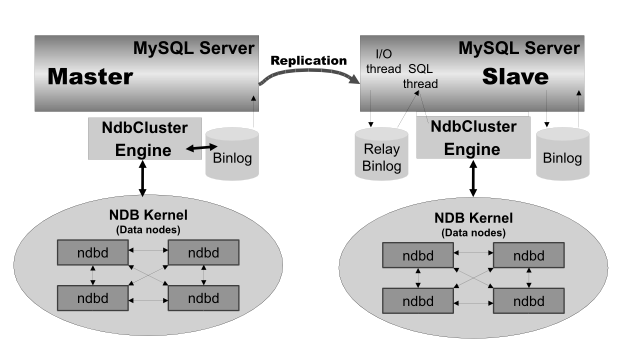

|
Spec-Zone .ru
спецификации, руководства, описания, API
|
MySQL Cluster supports asynchronous replication, more usually referred to simply as "replication". This section explains how to set up and manage a configuration in which one group of computers operating as a MySQL Cluster replicates to a second computer or group of computers. We assume some familiarity on the part of the reader with standard MySQL replication as discussed elsewhere in this Manual. (See Chapter 16, Replication).
Normal (non-clustered) replication involves a "master"
server and a "slave" server, the master being the source
of the operations and data to be replicated and the slave being the recipient of these. In MySQL Cluster,
replication is conceptually very similar but can be more complex in practice, as it may be extended to cover a
number of different configurations including replicating between two complete clusters. Although a MySQL Cluster
itself depends on the NDB storage engine for clustering functionality, it is not necessary to use
NDB as the storage engine for the slave's copies of the replicated tables
(see Replication from NDB to non-NDB tables). However, for maximum availability, it is possible (and
preferable) to replicate from one MySQL Cluster to another, and it is this scenario that we discuss, as shown in
the following figure:

In this scenario, the replication process is one in which successive states of a master cluster are logged and
saved to a slave cluster. This process is accomplished by a special thread known as the NDB binlog injector
thread, which runs on each MySQL server and produces a binary log (binlog). This
thread ensures that all changes in the cluster producing the binary log—and not just those changes that are
effected through the MySQL Server—are inserted into the binary log with the correct serialization order. We
refer to the MySQL replication master and replication slave servers as replication servers or replication nodes,
and the data flow or line of communication between them as a replication channel.
For information about performing point-in-time recovery with MySQL Cluster and MySQL Cluster Replication, see Section 17.6.9.2, "Point-In-Time Recovery Using MySQL Cluster Replication".
NDB API _slave status variables. NDB API counters can provide enhanced
monitoring capabilities on MySQL Cluster replication slaves. These are implemented as NDB statistics _slave status variables, as seen in the output of SHOW STATUS, or in the results of queries against the SESSION_STATUS or GLOBAL_STATUS table in a mysql client session connected to a MySQL Server that is
acting as a slave in MySQL Cluster Replication. By comparing the values of these status variables before and
after the execution of statements affecting replicated NDB tables, you can observe the corresponding actions taken on the NDB API
level by the slave, which can be useful when monitoring or troubleshooting MySQL Cluster Replication. Section 17.5.15, "NDB API Statistics Counters
and Variables", provides additional information.
Replication from NDB to
non-NDB tables. It is possible to replicate NDB tables from a MySQL Cluster acting as the master to tables using other MySQL
storage engines such as InnoDB or MyISAM on a slave mysqld.
However, because of differences between the version of mysqld provided with MySQL Cluster and that included with
MySQL Server 5.6, the slave server must also use a mysqld binary from the MySQL Cluster distribution. See Section 17.6.2, "General Requirements
for MySQL Cluster Replication".